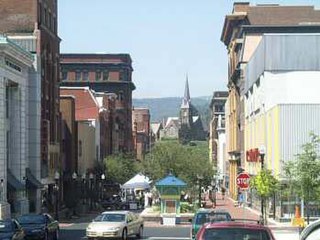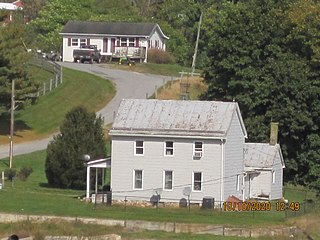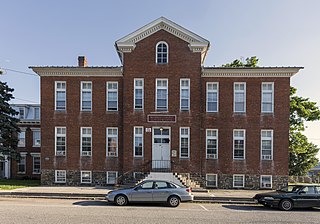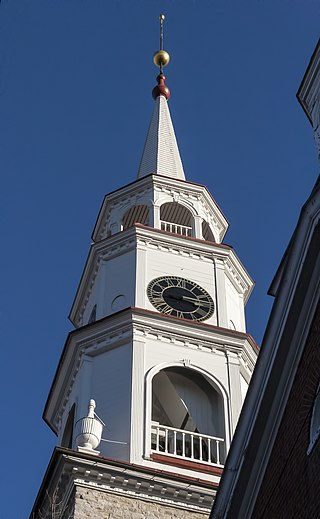
The Downtown Cumberland Historic District, also referred to as the Downtown Cumberland Mall, is the main shopping and dining district for the city of Cumberland, Maryland.

Oxon Cove Park and Oxon Cove Farm is a national historic district that includes a living farm museum operated by the National Park Service, and located at Oxon Hill, Prince George's County, Maryland. It is part of National Capital Parks-East. It was listed on the National Register of Historic Places in 2003.

Ellicott City Historic District is a national historic district in Ellicott City, Howard County, Maryland. The Ellicott City Station is a National Historic Landmark located within the district. The district encompasses a predominantly 19th century mill town whose origins date to 1772, including more than 200 18th- and 19th-century buildings. It was listed on the National Register of Historic Places in 1978. The 2016 Maryland flood severely impacted the historic district on July 30, 2016, as did another flood on May 27, 2018.

Saint Joseph College and Mother Seton Shrine are two closely related campuses in Emmitsburg, Maryland, United States. It forms a historic district that was listed on the National Register of Historic Places in 1976.

The Middletown Historic District comprises the historic center of Middletown, Maryland. Middletown became the chief community in the Middletown Valley in the late 18th century, retaining its importance until the 1930s, when the expanding influence of Frederick, Maryland, the construction of a bypass on US 40 and the abandonment of the Hagerstown and Frederick Railway produced a gradual decline. The historic district preserves many mid-19th-century buildings in the central downtown area. To the east, the district includes early 20th-century houses built along the trolley right-of-way, forming a streetcar suburb. The Airview Historic District includes a related area of early 20th century development to the east of town along the National Pike, separated from the main district by a section of newer development.

The Lawyers Hill Historic District is a national historic district located at Elkridge, Howard County, Maryland. The district encompasses a broad array of architectural styles ranging from 1738 Georgian Colonial to 1941 Georgian Revival. The collection of Victorian domestic architecture built during the 1840s to 1880s is unparalleled in the county, with no two houses the same. Some of the later cottages were designed by Philadelphia architect Brognard Okie. There are variations of the American Gothic Revival form, Italianate, Queen Anne, and Shingle-style structures. There is also a range of Colonial Revival houses, from craftsman era rustic cottages to more formal Georgian, and mass-produced Dutch Colonial models from the early 20th century.

The Inns on the National Road is a national historic district near Cumberland, Allegany County, Maryland. It originally consisted of 11 Maryland inns on the National Road and located in Allegany and Garrett counties. Those that remain stand as the physical remains of the almost-legendary hospitality offered on this well-traveled route to the west.

The Drummine Farm is a historic home and farm complex located at New Market, Frederick County, Maryland, United States. The main house was constructed about 1790 and is a 2+1⁄2-story structure of uncoursed fieldstone. The house retains Georgian stylistic influences in exterior and interior decorative detailing. The farm complex structures include a stone tenant house dated 1816, and four additional fieldstone buildings from the early 19th century: a smokehouse, a water storage house, a garden outhouse, and a large bank barn. Wooden farm buildings include a calf shed and a wagon shed with corn cribs from the late 19th century, a dairy barn with three cement stave silos from the 1930s, several sheds and garages, and a large pole barn.

St. Euphemia's School and Sisters' House is a historic school building and convent located at Emmitsburg, Frederick County, Maryland. It is a late-19th century school complex that consists of two attached brick buildings: a two and half story school building built about 1890, and a house that was used as a convent and built about 1860.

The Frederick Historic District is a national historic district in Frederick, Maryland. The district encompasses the core of the city and contains a variety of residential, commercial, ecclesiastical, and industrial buildings dating from the late 18th century to 1941. Notable are larger detached dwellings in the Queen Anne and American Foursquare architectural styles of the late 19th and early 20th centuries The churches reflect high style architecture ranging from Gothic and Greek Revival to Richardsonian Romanesque and Colonial Revival. The east side of the district includes the industrial buildings.

The New Market Historic District is a national historic district in New Market, Frederick County, Maryland. The district encompasses the town located along what was originally the National Pike. About 90 percent of the buildings in the historic district date from the 19th century and include Federal-style buildings and Greek Revival buildings, with a number of Victorian buildings, a larger example being the Ramsburg House.

The Mount Airy Historic District is a national historic district in Mount Airy, located in Carroll and Frederick County, Maryland. The district comprises a cohesive group of commercial, residential, and ecclesiastical buildings dating from the late 19th through early 20th centuries. The brick Baltimore and Ohio Railroad station, designed by E. Francis Baldwin and constructed in 1882, represents the town's origin as an early transportation center for the region, which dates back as early as 1838. A group of early-20th century commercial structures represent the rebuilding of Mount Airy's downtown after a series of fires between 1903 and 1926. The residential areas are characterized by houses illustrating vernacular forms and popular stylistic influences of the late 19th and early 20th century. Three churches are located within the district.

Creagerstown is an unincorporated community in Frederick County, Maryland, United States. It is playfully known by its residents as "4 miles from everywhere" because of its situation at 4 miles (6.4 km) from Thurmont, Woodsboro, Rocky Ridge, and Lewistown.

Rocky Ridge is an unincorporated community in Frederick County, Maryland, United States. The name "Rocky Ridge" likely refers to a ridge of ironstone which runs through the area.

Knoxville is an unincorporated community in Frederick and Washington counties, Maryland, United States. The Robert Clagett Farm and Magnolia Plantation are listed on the National Register of Historic Places.

Union Bridge station is a historic railway station in Union Bridge, Carroll County, Maryland. It was built in 1902 as a stop for the Western Maryland Railway. It is representative of the rural railway stations constructed during the late 19th and early 20th centuries. The station's two buildings are arranged with their south façades lengthwise fronting the railroad tracks.

Boonsboro Historic District is a national historic district at Boonsboro, Washington County, Maryland, United States. The district includes 562 contributing elements. Its component buildings chronicle the town's development from its founding in 1792 through the mid 20th century. Most of the late 18th and early 19th century development in Boonsboro occurred along Main Street, then part of a principal market road between Williamsport, Hagerstown, Frederick, and Baltimore, Maryland. They are mainly of log, frame, or brick construction, with a few stone buildings interspersed. The majority of the buildings in the district date from the 1820-1850 period coinciding with peak use years of the National Road. Other features of the district include the Boonsboro Cemetery laid out about 1855 in a 19th-century curving plan with a number of exceptionally artistic gravestones, and the office/depot of the Hagerstown-Boonsboro Electric Railway. The period of significance, from 1792 to 1959 tracks the continuous growth and evolution of the town through the date by which the district had substantially achieved its current form and appearance.
Potomac–Broadway Historic District is a national historic district at Hagerstown, Washington County, Maryland, United States. The district is located in the north downtown area and consists largely of a late 19th and early 20th century residential area with most buildings dating from 1870 to 1930. Architectural styles represented include Victorian Gothic, Queen Anne, Colonial Revival, and American Foursquare.

Maryland Route 550 is a state highway in the U.S. state of Maryland. The state highway runs 24.43 miles (39.32 km) from MD 26 in Libertytown north to Pen Mar Road in Fort Ritchie. MD 550 runs southeast–northwest across central Frederick County, connecting Fort Ritchie in the northeastern corner of Washington County and Libertytown with the towns of Thurmont and Woodsboro and the smaller communities of Creagerstown and Sabillasville. South of the highway's junction with U.S. Route 15 in Thurmont, the state highway passes through the wide valley of the Monocacy River; to the north, the highway passes along the northern edge of Catoctin Mountain and crests South Mountain near Blue Ridge Summit, Pennsylvania.

Foxville is an unincorporated community in Frederick County, Maryland, United States. Foxville is located on Maryland Route 77, 4.7 miles (7.6 km) west of Thurmont. Settled in the late 18th century, the historic village is situated between South Mountain to the west and Catoctin Mountain to the east. Catoctin Mountain Park, Cunningham Falls State Park, and the Appalachian Trail are all within a few miles of Foxville.























